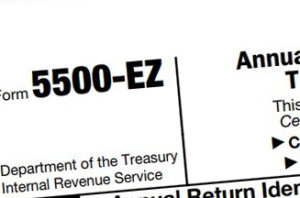7 Common Questions About 5500-EZ Filings
 When you operate a Solo 401(k) plan that is truly self-directed, you act as the plan administrator. In that role, it is your responsibility to manage IRS filings, including Form 5500-EZ, Annual Return of a One-Participant Retirement Plan.
When you operate a Solo 401(k) plan that is truly self-directed, you act as the plan administrator. In that role, it is your responsibility to manage IRS filings, including Form 5500-EZ, Annual Return of a One-Participant Retirement Plan.
With a little preparation and know how, filing form 5500-EZ can be quite simple. Some Solo 401(k) holders perform their own filing, while others will ask their CPA for assistance.
Following are some of the most common questions surrounding form 5500-EZ.
1 – What is Form 5500-EZ?
The 5500 series of forms are informational returns designed by the Department of Labor to collect general information about retirement plans. This information is used to monitor the state of the retirement savings system and provide data that can be used to shape government policy.
The 5500-EZ is a simplified version of the form designed for owner-only businesses.
2 – Who Must File?
Employers who operate what the IRS refers to as a “one-participant” plan must file using form 5500-EZ.
A one-participant plan may provide benefits to an owner, the owner’s spouse, one or more business partners, and the spouse of a business partner.
A one-participant plan may not provide benefits to any non-owner employees.
A filing is not required unless the total plan assets during the plan year are $250,000 or more. For most all Solo 401(k) plan sponsors, the plan year and the calendar year are the same, with the plan year ending on December 31st.
A 5500-EZ must be filed for a final plan year when a plan is terminated.
3 – When to File?
The filing of form 5500-EZ is due on the last day of the 7th month from the end of the plan year.
Since most all Solo 401(k) sponsoring businesses operate on a calendar year, that means the filing is due the last day of July in the following year.
If the last day of July falls on a weekend or holiday, the next business day becomes the filing deadline in that year.
When a plan is terminated, the end of the plan year is the last day of the month of termination. Form 5500-EZ must be filed by the end of the 7th month from that time.
For example, if you terminate your plan in August, you will need to file a final 5500-EZ by the last day of March in the following year. You can, of course, file at any time between August and March.
4 – How to File?
Form 5500-EZ can be filed by paper or electronically.
Use the fillable PDF available on the IRS website to file by mail.
The form can change from year-to-year, so be sure the form you access is for the appropriate tax year.
Use the EFAST2 system to file electronically. It can take a little while to get setup and verified on the EFAST2 system, so do not wait until the last minute.
5 – What Are the Plan Characteristic Codes for a Solo 401(k)?
The following plan characteristic codes apply to a standardized Solo 401(k):
2E – Profit Sharing
2J – 401(k) Feature
3B – Self-employed
3D – Pre-approved plan
If you have separate brokerage accounts for individual participants at a firm like Fidelity or Schwab, code 2R applies. If you are a single participant with a “trustee directed” brokerage account, or do not have a brokerage account, this code does not apply.
6 – How Do I Determine Plan Value?
Add up all the holdings of your Solo 401(k) plan, including cash, stocks, real estate, private placements, cryptocurrency, etc.
The value should reflect the current value of the asset as of the end of the plan year.
For assets like cash, stocks, and cryptocurrency, you can easily look up the value on a statement or exchange.
With real estate, realtor comps are usually sufficient. An appraisal may be necessary if you plan a taxable event such as a Roth conversion or distribution of an asset in-kind from your plan.
The value of a note is the open principal balance plus any accrued but unpaid interest.
With most private placements like multifamily real estate syndications, the asset value is the amount invested unless the investment sponsor provides you with an updated value. If you have received cash distributions, that would increase your plan’s cash balance while not impacting the value of the asset itself.
If you have taken a participant loan from your plan, that note balance is included in the plan value.
If you expect to file form 5500-EZ, be sure to perform a valuation at year end. You don’t want to be filing in July and trying to guess what values were 7 months ago.
7 – What is the Penalty for Failure to File?
Failure to file form 5500-EZ results in severe penalties. A fine of $250 per day, up to $150,000 per plan year is assessed.
A late-filing one-participant plan administrator with a Solo 401(k) may be eligible for relief per Revenue Procedure 2015-32.
We strongly recommend you work with your CPA when seeking such relief.
8 – Where Can I Get Help?
Most any CPA who works with small businesses should be familiar with the 5500-EZ filing. If your CPA is not able to help you, they should know someone in your community who can provide assistance.
Talk to An Expert Today!
Learn these little known strategies and tactics, and unlock your retirement plan today.
